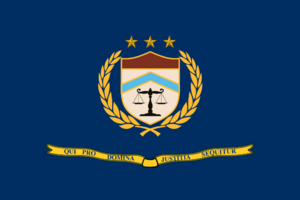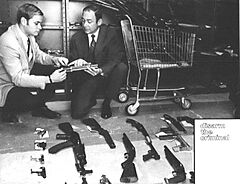Bureau of Alcohol, Tobacco, Firearms and Explosives facts for kids
Quick facts for kids Bureau of Alcohol, Tobacco, Firearms and Explosives |
|
|---|---|
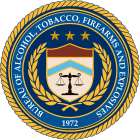
Seal of the ATF
|
|
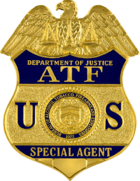
ATF agent badge
|
|

Flag
|
|
| Common name | Alcohol, Tobacco and Firearms |
| Abbreviation | ATF |
| Agency overview | |
| Formed | July 1, 1972 |
| Preceding agency |
|
| Employees | 5,285 (2021) |
| Annual budget | Approx. US$1.5 billion (2021) |
| Jurisdictional structure | |
| Federal agency | United States |
| Operations jurisdiction | United States |
| General nature | |
| Operational structure | |
| Headquarters | Ariel Rios Federal Building, Washington, D.C. 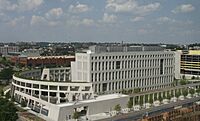 |
| Agency executive |
|
| Parent agency |
|
The Bureau of Alcohol, Tobacco, Firearms and Explosives (BATFE), commonly referred to as the ATF, is a domestic law enforcement agency within the United States Department of Justice. Its responsibilities include the investigation and prevention of federal offenses involving the unlawful use, manufacture, and possession of firearms and explosives; acts of arson and bombings; and illegal trafficking and tax evasion of alcohol and tobacco products. The ATF also regulates via licensing the sale, possession, and transportation of firearms, ammunition, and explosives in interstate commerce. Many of the ATF's activities are carried out in conjunction with task forces made up of state and local law enforcement officers, such as Project Safe Neighborhoods. The ATF operates a unique fire research laboratory in Beltsville, Maryland, where full-scale mock-ups of criminal arson can be reconstructed. The ATF had 5,285 employees and an annual budget of almost $1.5 billion in 2021. The ATF has received criticism over its handling of the Ruby Ridge siege, the Waco siege and other incidents.
Contents
History
The ATF was formerly part of the United States Department of the Treasury, having been formed in 1886 as the "Revenue Laboratory" within the Treasury Department's Bureau of Internal Revenue. The history of the ATF can be subsequently traced to the time of the revenuers or "revenoors" and the Bureau of Prohibition, which was formed as a unit of the Bureau of Internal Revenue in 1920. It was made an independent agency within the Treasury Department in 1927, was transferred to the Justice Department in 1930, and became, briefly, a division of the FBI in 1933.
When the Volstead Act, which established Prohibition in the United States, was repealed in December 1933, the Unit was transferred from the Department of Justice back to the Department of the Treasury, where it became the Alcohol Tax Unit (ATU) of the Bureau of Internal Revenue. Special Agent Eliot Ness and several members of The "Untouchables", who had worked for the Prohibition Bureau while the Volstead Act was still in force, were transferred to the ATU. In 1942, responsibility for enforcing federal firearms laws was given to the ATU.
In the early 1950s, the Bureau of Internal Revenue was renamed "Internal Revenue Service" (IRS), and the ATU was given the additional responsibility of enforcing federal tobacco tax laws. At this time, the name of the ATU was changed to the Alcohol and Tobacco Tax Division (ATTD).
In 1968, with the passage of the Gun Control Act, the agency changed its name again, this time to the Alcohol, Tobacco, and Firearms Division of the IRS and first began to be referred to by the initials "ATF". In Title XI of the Organized Crime Control Act of 1970, Congress enacted the Explosives Control Act, 18 U.S.C.A. Chapter 40, which provided for close regulation of the explosives industry and designated certain arsons and bombings as federal crimes. The Secretary of the Treasury was made responsible for administering the regulatory aspects of the new law, and was given jurisdiction over criminal violations relating to the regulatory controls. These responsibilities were delegated to the ATF division of the IRS. The Secretary and the Attorney General were given concurrent jurisdiction over arson and bombing offenses. Pub.L. 91-452, 84 Stat. 922, October 15, 1970.
In 1972, the ATF was officially established as an independent bureau within the Treasury Department on July 1, 1972, this transferred the responsibilities of the ATF division of the IRS to the new Bureau of Alcohol, Tobacco, and Firearms. Rex D. Davis oversaw the transition, becoming the bureau's first director, having headed the division since 1970. During his tenure, Davis shepherded the organization into a new era where federal firearms and explosives laws addressing violent crime became the primary mission of the agency. However, taxation and other alcohol issues remained priorities as the ATF collected billions of dollars in alcohol and tobacco taxes, and undertook major revisions of the federal wine labeling regulations relating to use of appellations of origin and varietal designations on wine labels.
In the wake of the terrorist attack on the World Trade Center and the Pentagon on September 11, 2001, President George W. Bush signed into law the Homeland Security Act of 2002. In addition to the creation of the Department of Homeland Security, the law shifted ATF from the Department of the Treasury to the Department of Justice. The agency's name was changed to Bureau of Alcohol, Tobacco, Firearms, and Explosives. However, the agency still was referred to as "the ATF" for all purposes. Additionally, the task of collection of federal tax revenue derived from the production of tobacco and alcohol products and the regulatory function related to protecting the public in issues related to the production of alcohol, previously handled by the Bureau of Internal Revenue as well as by ATF, was transferred to the newly established Alcohol and Tobacco Tax and Trade Bureau (TTB), which remained within the Treasury Department. These changes took effect January 24, 2003.
Activities
1972–2000
Complaints regarding the techniques used by ATF in their effort to generate firearm cases led to hearings before Congressional committees in the late 1970s and 1980s. At these hearings, evidence was received from citizens who had been charged by ATF, from experts who had studied ATF, and from officials of the bureau itself. A Senate subcommittee report stated, "Based upon these hearings it is apparent that ATF enforcement tactics made possible by current federal firearms laws are constitutionally, legally, and practically reprehensible." The Subcommittee received evidence that ATF primarily devoted its firearms enforcement efforts to the apprehension, upon technical malum prohibitum charges, of individuals who lack all criminal intent and knowledge. Evidence received demonstrated that ATF agents tended to concentrate upon collector's items rather than "criminal street guns". In hearings before ATF's Appropriations Subcommittee, testimony was submitted estimating that 75 percent of ATF gun prosecutions were aimed at ordinary citizens with no criminal intent. The Firearm Owners Protection Act of 1986 addressed some of the abuses noted in the 1982 Senate Judiciary Subcommittee report.
Rodney King riots
On May 1, 1992, 50 ATF agents were summoned upon to provide extra support for local police departments in Los Angeles County in response to the ongoing Rodney King riots. The next day, the ATF activated its Special Response Team tactical unit to escort firefighters in high-risk areas, pair up with local police in protecting certain establishments, and execute search warrants for looted firearms. During the riots, a total of 4,690 firearms were looted and stolen; over the next 10 days, ATF recovered fewer than 200 firearms.
Domestic terrorism towards ATF
Timothy McVeigh cited Ruby Ridge and Waco Siege as his motivation for the Oklahoma City Bombing, which took place on April 19, 1995, exactly two years after the end of the Waco Siege. McVeigh's criterion for attack sites was that the target should house at least two of three federal law enforcement agencies: the Bureau of Alcohol, Tobacco, and Firearms (ATF), the Federal Bureau of Investigation (FBI), and the Drug Enforcement Administration (DEA). He regarded the presence of additional law enforcement agencies, such as the Secret Service or the U.S. Marshals Service, as a bonus. Until the September 11, 2001, attacks, the Oklahoma City bombing was the deadliest terrorist attack in the history of the United States, and remains the deadliest incident of domestic terrorism in the country's history. McVeigh was executed for this mass murder by lethal injection on June 11, 2001, at the Federal Correctional Complex in Terre Haute, Indiana.
2000–present
The ATF was criticized for poor planning leading up to a shootout at Stevenson Ranch, California, in 2001, which resulted in the immediate deaths of a deputy sheriff as well as the suspect.
Following the attacks on September 11, 2001, the ATF expanded regulations covering fuels used in amateur rocketry, including ammonium perchlorate composite propellant (APCP). Two rocketry clubs, the National Association of Rocketry (NAR) and the Tripoli Rocketry Association (TRA), argued that APCP is not explosive and that the ATF's regulations were unreasonable. The NAR and TRA won their lawsuit against the ATF in 2009, lifting the government restrictions. The associations maintain their own restrictions, and rocketry is also regulated by the Federal Aviation Administration (FAA).
Between May 2004 and August 2005, ATF agents, in conjunction with Virginia state, county, and city police, conducted an operation at eight gun shows in the Richmond area to reduce straw purchases for criminals. In a February 2006 House subcommittee hearing, the show's owner said: "People were approached and discouraged from purchasing guns. Before attempting to purchase, they were interrogated and accused of being in the business without a license, detained in police vehicles, and gun buyer's homes were visited by police, and much more." A gun salesman testified that he was singled out for harassment by two ATF agents. The owner of a gun shop testified that he thought agents questioned female customers too often. He said that times had changed and more women were shopping for guns, adding: "It seems, however, to be the prevailing opinion for law enforcement at the gun show that any woman who brings a male friend for advice or support must be making a straw purchase." A private investigator said the National Rifle Association (NRA) contracted her to go to Richmond to investigate dozens of complaints by NRA members of "massive law enforcement presence, residence checks, and minority buyers being followed, pulled over and their legally purchased guns seized." The purchasers were compelled by an ATF letter to appear at ATF offices to explain and justify their purchases. ATF stated this was a pilot program that ATF was planning to apply throughout the country. In Pittsburgh, Pennsylvania, ATF agents visited a gun show's customers' homes a week after the show, demanding to see the buyers' guns or sale paperwork and arresting those who could not—or would not—comply.
A September 2008 report by the Justice Department's Office of the Inspector General determined that 76 firearms and 418 laptop computers were lost, stolen, or missing from ATF, after a 59-month audit period between 2002 and 2007.
Under operations "Fast and Furious", "Too Hot to Handle", and "Wide Receiver", indictments show that the Phoenix ATF Office, over protests from the gun dealers and some ATF agents involved and without notifying Mexican authorities, facilitated the sale of over 2,500 firearms (AK-47 rifles, FN 5.7mm pistols, and .50 caliber rifles) to traffickers destined for Mexico. Many of these same guns are being recovered from crime scenes in Arizona and throughout Mexico, which is artificially inflating ATF's eTrace statistics of U.S. origin guns seized in Mexico. One gun is alleged to be the weapon used by a Mexican national to murder Customs and Border Protection Agent Brian Terry on December 14, 2010. ATF and DOJ denied all allegations. After appearing at a Congressional Hearing, three supervisors of Fast and Furious (William G. McMahon, Newell, and David Voth) were reported as being transferred and promoted by ATF. ATF denied the transfers were promotions.
In June 2011, Vince Cefalu, an ATF special agent for 24 years who in December 2010 exposed ATF's Project Gunrunner scandal, was notified of his termination. Two days before the termination, Rep. Darrell Issa (R-CA), chairman of the House Committee on Oversight and Government Reform, sent a letter to the ATF warning officials not to retaliate against whistleblowers. Cefalu's dismissal followed allegations that ATF retaliates against whistleblowers. ATF spokesman Drew Wade denied that the bureau is retaliating but declined to comment about Cefalu's case.
In 2015, a proposal by the ATF to prohibit sales of certain 5.56 x 45mm ammunition was dropped following a negative response from the public and the legislature.
In 2022, the DOJ Office of the Inspector General (OIG) conducted an audit which found that "thousands of firearms, firearm parts, and ammunition had been stolen from National Firearms and Ammunition Destruction (NFAD) from 2016 to 2019." The NFAD is the branch of the ATF uses to dispose of firearms forfeited to the ATF. The report also stated that the ATF has improved its process to reduce thefts but that it still has not implemented all of the recommendations made by the DOJ.
In 2023, federal Judge Reed O'Connor of the Northern District of Texas vacated the Bureau's attempt to expand the definition of a firearm frame or receiver. Judge O'Connor ruled ATF exceeded its statutory authority in attempting to redefine these terms and implement regulations of so-called "readily convertible" or "80% receiver" kits.
Personnel
ATF, as a bureau, consists of several different groups that each have their own respective role, commanded by a director. Special Agents are empowered to conduct criminal investigations, defend the United States against international and domestic terrorism, and work with state and local police officers to reduce violent crime on a national level. ATF Special Agents may carry firearms, serve warrants and subpoenas issued under the authority of the United States and make arrests without warrant for any offense against the United States committed in their presence, or for any felony cognizable under the laws of the United States if they have reasonable grounds to believe that the person to be arrested has committed or is committing such felony 18 U.S.C. § 3051. Specifically, ATF Special Agents have lead investigative authority on any federal crime committed with a firearm or explosive, as well as investigative authority over regulatory referrals and cigarette smuggling. All ATF Special Agents require a Top Secret (TS) security clearance, and in many instances, need a higher level, TS/SCI/SAP (Top Secret/Sensitive Compartmented Information/Special Access Programs) clearance. In order to get a security clearance, all potential ATF Special Agents must pass a detailed series of Single Scope Background Investigations (SSBI). ATF Special Agents consistently rank at the top or near the top of all federal agencies in cases referred for prosecution, arrests made, and average time per defendant on an annual basis. Special Agents currently comprise around 2,400 of the Agency's approximately 5,000 personnel.
Industry Operations Investigators (IOIs) are the backbone of the ATF regulatory mission. Their work is primarily investigative and routinely involves contact with, and interviews of, individuals from all walks of life and all levels of industry and government. Investigations and inspections pertain to the industries and persons regulated by ATF (e.g., firearms and explosives users, dealers, importers, exporters, manufacturers, wholesalers, etc.); and are under the jurisdiction of the Gun Control Act, National Firearms Act, Arms Export Control Act, Organized Crime Control Act of 1970, and other Federal firearms and explosives laws and regulations.
The remainder of the bureau is personnel in various staff and support roles from office administrative assistants to intelligence analysts, forensic scientists, legal counsel, and technical specialists. Additionally, ATF relies heavily on state and local task force officers to supplement the Special Agents and who are not officially part of the ATF roster.
Training
Basic special agent training for new hires consists of a two-part training program. The first part is the Criminal Investigator Training Program (CITP) provided by the U.S. Department of Homeland Security's Federal Law Enforcement Training Center (FLETC) in Glynco, Georgia. The CITP provides fundamental training in the techniques, concepts, and methodologies of conducting criminal investigations. Some of the subjects covered in the training include training in firearms, physical techniques, driving techniques, handcuffing, interviewing, surveillance, crime scene management, photography, basic firearms training, and federal court procedures. The CITP lasts approximately 12 weeks. Each class consists of 48 students, of whom approximately half are ATF trainees. The remaining portion of the CITP class consists of students from other federal agencies.
The second part of training is the Special Agent Basic Training (SABT), which is conducted at FLETC. The SABT for special agent trainees is a demanding and intensive training program that covers a wide range of disciplines including firearms and ammunition identification; firearms trafficking; report writing, interviewing techniques; alcohol/tobacco diversion investigations; explosives and fire/arson investigations; firearms and tactical training, close quarter countermeasures; field operations, undercover techniques; and physical conditioning. The SABT consists of approximately 15 weeks of training with a class of 24 student trainees.
Industry Operations Investigator Basic Training (IOIBT) is a comprehensive 10-week program designed to train newly hired industry operations investigators (IOI) in the basic knowledge, skills, and abilities they need to effectively conduct inspections of firearms and explosives licensees and permittees, as well as provide assistance to other Federal, State, and local law enforcement agencies. Successful completion of IOIBT is mandatory in order for the newly hired IOI to maintain their employment.
Firearms
Members of ATF special agent ranks are issued the Glock 19M as their primary duty weapon and are trained in the use of, and issued, certain rifles and shotguns. The ATF Special Response Team (SRT) is armed with Colt M4 carbines and other firearms.
Organization
The ATF is organized as follows:
- Director
- Chief of Staff
- Chief Counsel
- Deputy Director (Chief Operating Officer)
- Office of Field Operations
- Office of Human Resources and Professional Development
- Office of Management
- Office of Enforcement Programs and Services
- Office of Professional Responsibility and Security Operations
- Office of Public and Governmental Affairs
- Office of Science and Technology
- Office of Strategic Intelligence and Information
Field divisions
The ATF has 26 field divisions across the nation in major cities. Those cities are: Atlanta, Baltimore, Boston, Charlotte, Chicago, Columbus (OH), Dallas, Denver, Detroit, Houston, Kansas City (MO), Los Angeles, Louisville, Miami, Nashville, New Orleans, New York City, Newark, Philadelphia, Phoenix, San Francisco, Seattle, St. Paul, Tampa, and Washington, D.C. Also, there are field offices in different countries such as Canada, Mexico, El Salvador, Colombia, Iraq, Lithuania, and in the Caribbean.
Regulation of firearms
ATF is responsible for regulating firearm commerce in the United States. The bureau issues Federal Firearms Licenses (FFL) to sellers and conducts firearms licensee inspections. The bureau is also involved in programs aimed at reducing gun violence in the United States, by targeting and arresting violent offenders who unlawfully possess firearms. ATF was also involved with the Youth Crime Gun Interdiction Initiative, which expanded tracing of firearms recovered by law enforcement and the ongoing Comprehensive Crime Gun Tracing Initiative. ATF also provides support to state and local investigators through the National Integrated Ballistic Information Network (NIBIN) program.
In 2006, Congress made the ATF head subject to Senate confirmation and, until recently, only one nominee had not been blocked from heading the ATF in the Senate. Steven Dettelbach became the second in July 2022 after being nominated by President Joe Biden.
Firearms tracing
ATF's Comprehensive Crime Gun Tracing Initiative is the largest operation of its kind in the world. In FY07, ATF's National Tracing Center processed over 285,000 trace requests on guns for over 6,000 law enforcement agencies in 50 countries. ATF uses a Web-based system, known as eTrace, that provides law enforcement agencies with the capability to securely and electronically send trace requests, receive trace results, and conduct basic trace analysis in real time. Over 2,000 agencies and more than 17,000 individuals currently use eTrace, including over 33 foreign law enforcement agencies. Gun tracing provides information to federal, state, local, and foreign law enforcement agencies on the history of a firearm from the manufacturer (or importer), through the distribution chain, to the first retail purchaser. This information is used to link suspects to firearms in criminal investigations, identify potential traffickers, and detect in-state, interstate, and international patterns in the sources and types of crime guns. These results are then used to help the courts prosecute the offenders and attempt to clamp down on firearm crime.
Firearms ballistic tracing
ATF provides investigative support to its partners through the National Integrated Ballistic Information Network (NIBIN), which allows federal, state, and local law enforcement agencies to image and compare crime gun evidence. NIBIN currently has 203 sites. In FY07, NIBIN's 174 partner agencies imaged more than 183,000 bullets and casings into the database, resulting in over 5,200 matches that provided investigative leads.
Regulation of explosives
With the passage of the Organized Crime Control Act (OCCA) in 1970, ATF took over the regulation of explosives in the United States, as well as prosecution of persons engaged in criminal acts involving explosives. One of the most notable investigations successfully conducted by ATF agents was the tracing of the vehicle used in the World Trade Center 1993 bombings, which led to the arrest of persons involved in the conspiracy.
ATF also enforces provisions of the Safe Explosives Act, passed after 9/11 to restrict the use/possession of explosives without a federal license to use them. ATF is considered to be the leading federal agency in most bombings that occur within the U.S., with exception to bombings related to international terrorism (investigated by the FBI).
ATF currently trains the U.S. military in evidence recovery procedures after a bombing. All ATF Agents are trained in post-blast investigation; however ATF maintains a cadre of approximately 150 highly trained explosive experts known as Certified Explosives Specialists (CES). ATF/CES Agents are trained as experts regarding Improvised Explosive Devices (IED's), as well as commercial explosives. ATF Agents work closely with state and local Bomb Disposal Units (bomb squads) within the United States.
Directors
A list of ATF directors since becoming a Bureau on July 1, 1972:
- 1970–1978: Rex D. Davis (b. 1924 – d. 2008) (Prior to the establishment of ATF as an independent bureau within the Treasury Department in 1972, from 1970 to 1972, Davis headed its predecessor, the ATF division of the IRS, and oversaw its transition to an independent bureau.)
- 1979–1982: G. R. Dickerson
- 1982–1993: Stephen Higgins (b. 1938)
- 1993–1999: John Magaw (b. 1935)
- 1999–2004: Bradley A. Buckles (b. 1949)
- 2004: Edgar A. Domenech (1st time—acting)
- 2004–2006: Carl Truscott (b. 1957)
- 2006: Edgar A. Domenech (2nd time—acting)
- September 2006 – January 20, 2009: Michael Sullivan (acting) (b. 1954)
- January 20, 2009 - April 8, 2009: Ronald "Ronnie" A. Carter (acting)
- April 8, 2009 – August 30, 2011: Kenneth E. Melson (acting) (b. ~ 1948)
- August 31, 2011 – March 31, 2015: B. Todd Jones (acting August 31, 2011 – July 31, 2013; b. 1957)
- April 1, 2015 – April 30, 2019: Thomas Brandon (ATF Deputy Director, Acting Director)
- May 1, 2019 – June 3, 2021: Regina Lombardo (ATF Deputy Director, Acting Director)
- June 4, 2021 – April 25, 2022: Marvin Richardson (ATF Deputy Director, Acting Director)
- April 25, 2022 – July 13, 2022: Gary M. Restaino (U.S. Attorney for the District of Arizona, Acting Director)
- July 13, 2022–Present: Steve Dettelbach (b. 1965)
See also
 In Spanish: Agencia de Alcohol, Tabaco, Armas de Fuego y Explosivos para niños
In Spanish: Agencia de Alcohol, Tabaco, Armas de Fuego y Explosivos para niños
- Title 27 of the Code of Federal Regulations
- ATF gunwalking scandal
- Center for Intelligence and Security Studies
- Diplomatic Security Service (DSS)
- Drug Enforcement Administration (DEA)
- Immigration and Customs Enforcement (ICE)
- List of United States federal law enforcement agencies
- Under and Alone



